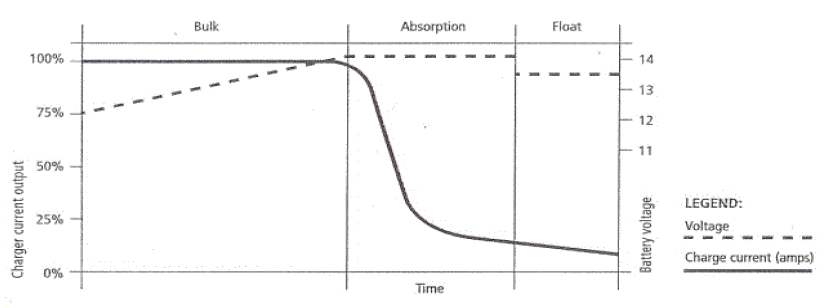Battery Charging System on Foretravel RV
As new technology advanced the way the batteries are charged, it's important to understand the principal of how the three-stage charging system works. Prior to the three-stage system the batteries were charged with a converter that used constant voltage. This was good for the old wet cell lead acid batteries, but not for the new Gel, AGM and maintenance free batteries. These type of batteries need to have the voltage and current controlled by the charger. The advanced multi-stage battery charger ensures that your batteries receive optimum charging, with the delivery of an accurate three-stage charge cycle. Three-stage charging results in batteries charging faster and more effectively than with a regular converter. This maximizes the amount of time that full AC power is available and minimizes generator run time.
The new charging systems feature a microprocessor-controlled three-stage charging process commonly found in advanced battery chargers. The three stages are known as the bulk, absorption, and float stage, and follow the ideal charge curves provided by manufacturers of deep-cycle batteries used in our coaches.
The microprocessor controller cycles through these stages, by precisely regulating the voltage and current delivered to the battery. Cycling through these stages during charging ensures a fast, safe and complete charge, without risk of excessive gassing, over-charging and battery damage.

BULK
The first stage in the charging process is a constant current mode that replaces 80% of the battery's capacity very quickly. The charger applies its maximum output current, or as much as the battery will take, while the battery voltage rises. When the battery voltage reaches a predetermined level the operation switches to the next stage, which is the absorption stage.
ABSORPTION
The second stage is a constant voltage mode and replaces the remaining 20% capacity. The charger voltage is held steady while the current falls as the battery approaches full charge.
FLOAT
This is the final stage and the charger voltage is lowered and held constant at a safe value of 13.5 volts DC. This prevents overcharging, while allowing the charger to supply enough current to maintain the battery at a full state of charge. The float stage makes up for the self-discharge losses of the battery and enables support of additional DC loads of your coach.
Now that you know how the charging system works you must remember one thing. When you decide to change to another type of battery you must have the setting changed to reflect the charging parameters for the new type of battery you have chosen. Too often you say your batteries are not charging as they should only to find out that the charging system is set incorrectly for the battery you have chosen. The amp-hour, voltage, temperature and other settings should be checked or changed on the control panel or dip switches set to reflect the correct settings for the new batteries.
By Jack Bradshaw - Reprinted from Winter 2008 Motorcader